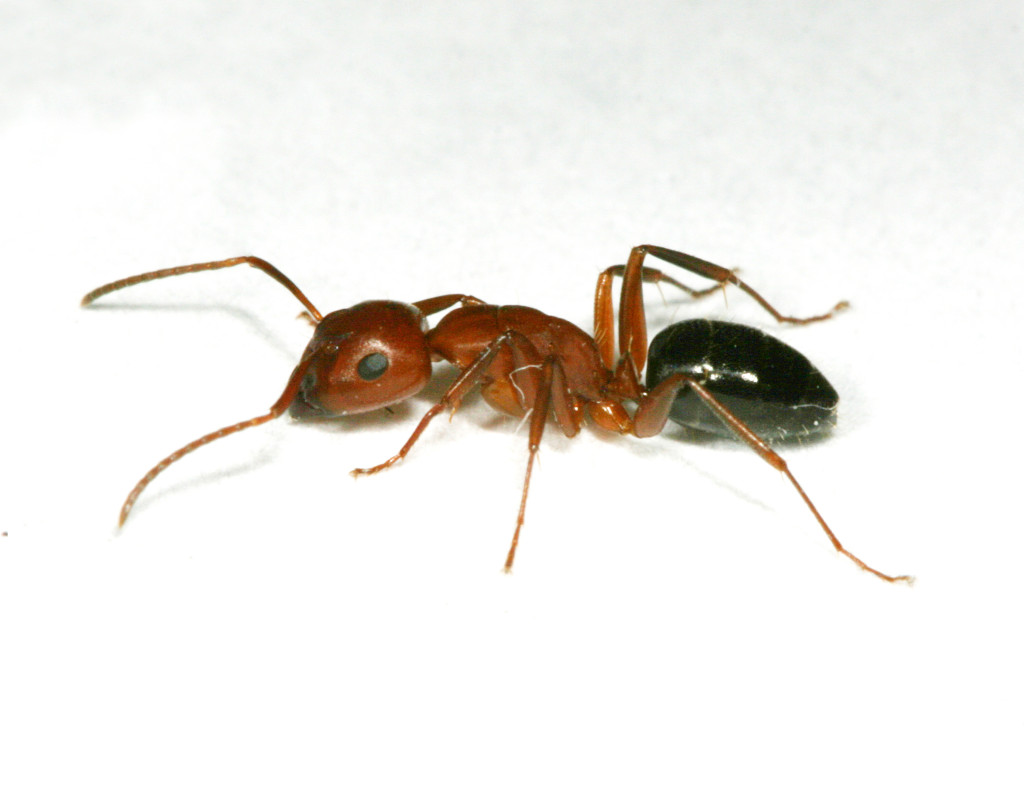
Carpenter ants are recognized by their relatively large size, single node and evenly rounded profile.
Carpenter ants are a common sight around Texas homes throughout the year. Although their natural nesting sites are in trees, carpenter ants can also invade and live indoors. Texas carpenter ant species are not usually destructive to homes, however they can become a nuisance.
Carpenter ants are often first noticed in late winter and early spring. This is the time when carpenter ants and other ants emerge to mate and attempt to start new colonies. These reproductive forms are identified by their two pairs of wings and relatively large size. The presence of winged ants indoors generally means that a nest is located in the structure.
Identification
Carpenter ants are among the larger ants found in Texas homes and yards. There are 18 recorded species of carpenter ants in the state. The most common indoor species is 1/4-3/8 inch-long with a black tail (abdomen) and reddish-brown head and thorax. Winged forms of this ant may be entirely black. Workers of other Texas carpenter ant species range in color from yellow to black. Other key distinguishing characters of these ants include a pinched waist, elbowed antennae (these characters easily distinguish ants from termites), a single bump or node between the abdomen and thorax, and an evenly rounded thorax when viewed from the side with a hand lens.
Carpenter ant reproductives or swarmers are winged, sexually mature ants that range in size from 1/4-1/2 inch-long. Hundreds of reproductive males and females may appear in a home over a several day period as the swarmers emerge for mating.
Damage
Carpenter ants do not eat wood, and generally are not as damaging as termites. Carpenter ants use narrow, protected void areas for nests and may be found in doors, window frames, and walls. Southern carpenter ant species prefer to nest in existing voids and cavities and do not usually excavate large nests in wood. For this reason, and because they tend to have smaller colonies, Texas carpenter ants are not as destructive as species found in the northwest and northeastern regions of the United States. At worst, carpenter ants may, on occasion, cause minor damage to isolated pieces of wood. Because carpenter ants are classified as wood-destroying insects, however, they are reportable on real estate transactions and can affect the resale value of a home.
Control
Carpenter ant control can be difficult. The surest way to eliminate a carpenter ant infestation is to locate and treat the nest, or nests. Carpenter ants make their homes in a variety of sites including solid wood, hollow core doors, window and door frames, hollow walls, insulation, cardboard boxes, etc. Although carpenter ants can bore into sound, dry wood, they prefer using existing cavities or excavating softer materials, especially near a moisture source.
Carpenter ant nests can sometimes be located by the presence of small piles of sawdust, or frass. This frass consists of wood shavings or other material excavated from the ant’s nests, as well as tiny fragments of dead ants and other insects. The presence of frass is a good sign that a nest is nearby. Carpenter ant frass is usually pushed out of a small hole in the nest chamber. If you can find such a hole, it frequently leads directly into the nest chamber.
Once a nest is located, it can be treated with an insecticide dust labeled for use in wall voids of homes. Pest control operators typically use insecticide dusts containing deltamethrin (DeltaDust®), cyfluthrin (Tempo® Dust) or carbaryl (Sevin®), or injectable aerosol sprays, when treating suspect wall voids or other nest sites. Such treatments can generally be made very safely with little or no chance of exposing residents to pesticides.
Should you attempt carpenter ant control yourself? Although do-it-yourself drilling and treating walls is possible, an easier approach is the use of baits. Carpenter ants have traditionally been difficult to lure with baits, however some new products may be worth trying. Advance™ Carpenter Ant Bait and Maxforce® Carpenter Ant Bait Gel, and have been used successfully against carpenter ants. These baits may be purchased online in most states. These products should be placed outdoors along carpenter ant foraging trails. Containerized ant baits often include label recommendations for indoor use against carpenter ants, however they have had little reported success against our Texas species. Commercial boric acid baits may also control some colonies. Baits with lower percentages of boric acid (1-2%) appear to work best. Fire ant baits are unattractive to carpenter ants.
Baits should be placed near ant trails or wherever carpenter ants are seen. The best way to locate outdoor foraging trails is to use a flashlight at night in warm weather, when the ants are most active. Trails will be found along fences or tree branches, wires, etc. Once picked up by ants, baits are transported to the colony where they are shared with the queen and other ants. If one bait seems unattractive when first offered, try it again in another month. Carpenter ants go through seasonal changes in their food preferences– preferring sweets at times, and proteins at other times. Do not use other pesticides near sites where you are baiting, as this may repel the ants.
For more information
For more information on carpenter ants and their control, request publication E-412, Carpenter Ants, or B-6183 Managing Household Ant Pests.
Author:
Michael Merchant, Ph.D., Professor and Extension Urban Entomologist, Texas AgriLife Extension Service